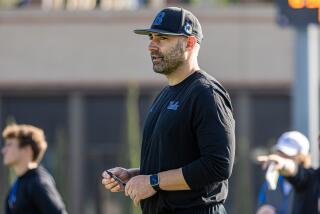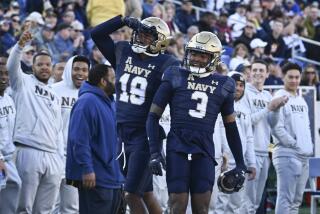Navy Coach Uzelac Wants More Chances to Blow Smoke
ANNAPOLIS, Md. — It became a post-game ritual, those Saturday afternoons when Elliot Uzelac would proudly puff cigars following University of Michigan football wins. And there were enough victories in his latest four-year stint there -- the Wolverines were 44-16-1 between 1982 and 1986 -- for the non-smoking Uzelac to pick up an acquired taste.
He had no idea that the head coaching job at Navy would be a near-habit breaker.
“That first year (1987) I had two cigars in 11 weeks, and I had just three cigars last year,” said Uzelac, laughing. “I said ‘Holy smokes, now I have a taste for them and I don’t have a chance to do it.’ This year, I hope to increase that opportunity.”
Optimistic is probably the best word to describe Uzelac as he heads into his third year of a four-year contract with Navy. Surely back-to-back seasons of 2-9 and 3-8 aren’t the best way to build one’s optimism, but Uzelac says the team is on track to have a winning record this season; host this December’s Liberty Bowl game (courtesy of the game’s tie-in with the winner of the Commander-in-Chief’s trophy), and, two years from now, regain the national prominence that has eluded Navy football since their last bowl appearance eight years ago.
“This year our players are stronger, their overall strength is better and they have a good attitude,” Uzelac said. “We have to have a minimum of injuries and we can’t go on a roller coaster. We have to have a level that increases all the way to the Army game.”
So maybe Navy can finish above .500, and perhaps the Middies can beat Air Force and Army and go to the Liberty Bowl. But does Uzelac really believe the Middies, who haven’t beaten a Division I-A team in more than three years, can gain national prominence over the next two years?
University of Virginia Coach George Welsh, the last coach to enjoy success at Navy, says sustaining a nationally prominent program at any academy is “extremely unlikely” in this day of redshirting and with the military obligation that awaits Navy players.
“On any one particular year you have a shot. To do it four or five years and be consistent, it’s very unlikely,” said Welsh, who led the Middies to five winning seasons and three bowl appearances between 1973 and 1981. “Our feeling was you could have better football players coming if their wasn’t a service obligation. When a kid is 17 or 18 and has those years looking at him after school, that’s a big stumbling block. It makes it very unlikely you can stay at a competitive level with a service academy team.”
But that doesn’t dampen Uzelac’s expectations of a competitive team on a national level.
“I expect it,” said Uzelac, without hesitation. “We may be a year or two off, but we will eventually get there. There’s no doubt we can reach the same level of football excellence as the other two academies.
“We’re making adjustments in our schedule, developing a balance like other schools,” he said of the appearance of teams such as Akron, Toledo, Bowling Green and Richmond on future Navy schedules. Contracts with Syracuse and Pittsburgh have run out. “And we’ve completely restructered our recruiting to a point where now it’s really advanced. You take those two things, and you see a bright future.”
It was a bright future that Uzelac was looking forward to when he left his offensive line coaching job at Michigan in December 1986 to accept the Navy position that he described at his first news conference as “the job I dreamed about for a long time.”
His dream-job turned almost nightmarish when Uzelac, a Navy assistant in 1971 and 1972, caught a glimpse of the team that was to take the field in his first season.
“I didn’t know when we got here that we were as down as we were; for whatever reasons we were really lacking in talent,” Uzelac said. “We had no starters returning on defense, which was very unusual. When we opened, we had four players starting for us that a year before were sitting in the stands with the brigade. We just didn’t have the foundation most good football teams have.”
The result was a 2-9 team that averaged 14 points a game and allowed almost 29. The victories were against Delaware and Pennsylvania. Mixed in with the not-so-surprising losses to Notre Dame, Pittsburgh and Syracuse were unexpected defeats to Lehigh and William and Mary.
“We tried to adapt, we tried to put in an offense and defense that would not ask them to do things they weren’t capable of,” Uzelac said of that first year. “But things were so spread out we couldn’t hide our weaknesses. At times they played every bit as hard as they could have -- but yet that still was not good enough.
“We were in a situation where we didn’t have enough athletic talent to compete with the teams on our schedule.”
The struggle continued in Uzelac’s second season. Among the eight defeats was a demoralizing 42-35 loss to The Citadel -- a Division I-AA team -- in the fourth game of the season.
Despite the 3-8 record, there were some bright spots last season: The Middies played tough against Notre Dame, the national champions, in a 22-7 loss; the seniors on the team began to provide leadership, and Uzelac’s first full recruiting class, although young, began to show some promise.
“The recruiting the first year was OK, but it wasn’t where it should have been because of my getting here so late,” Uzelac said. “Now we’ve come back with two good classes back to back -- our sophomores and freshmen are good.
“It just seems like now we’re starting to mold a good, solid football team. We’re not there yet because it’s a very young team, and with the maturity level of some players you have to wait and see what happens when they get in games. But we are on schedule as far as recruiting.”
A key to Navy’s success this season will be at quarterback, where talented, but inconsistent, juniors Alton Grizzard and Gary McIntosh will be competing for the starting job. The two alternated at running the wishbone offense last season, but Uzelac said he would go with just one player when the season starts.
“I think they both improved in their so-called weaker areas -- Grizzard is the better passer now, and McIntosh is better at the option,” Uzelac said. “They were both inconsistent last year; at times we broke down and misread things and did not run it as well as we could have. This year, our consistency will be higher. It’s a very good situation for us, because the competition between the two will elevate the level of play at the position.”
Uzelac has also been pleased with the early play at fullback, where returning starter Deric Sims, a junior, is being challenged by sophomore Donald Ferraro and junior Dominic Flis.
The offensive line is expected to be anchored by junior Greg Hlatky, who Uzelac said came into camp at almost 270 pounds, 30 pounds heavier than last season. And on defense, senior David Lowe and junior Anthony Domino lead an experienced corps of outside linebackers that should be the strength of the unit.
Even with Uzelac’s optimism, the team still must play Notre Dame (ranked second in the AP pre-season poll), Syracuse (13th), Brigham Young (19th), and Pittsburgh (20th). “Navy’s toughest this decade,” is how Uzelac decribes it. The schedule, combined with the stringent entrance requirements to the academy that limits certain recruits, would appear to indicate another long, losing season.
More to Read
Go beyond the scoreboard
Get the latest on L.A.'s teams in the daily Sports Report newsletter.
You may occasionally receive promotional content from the Los Angeles Times.










